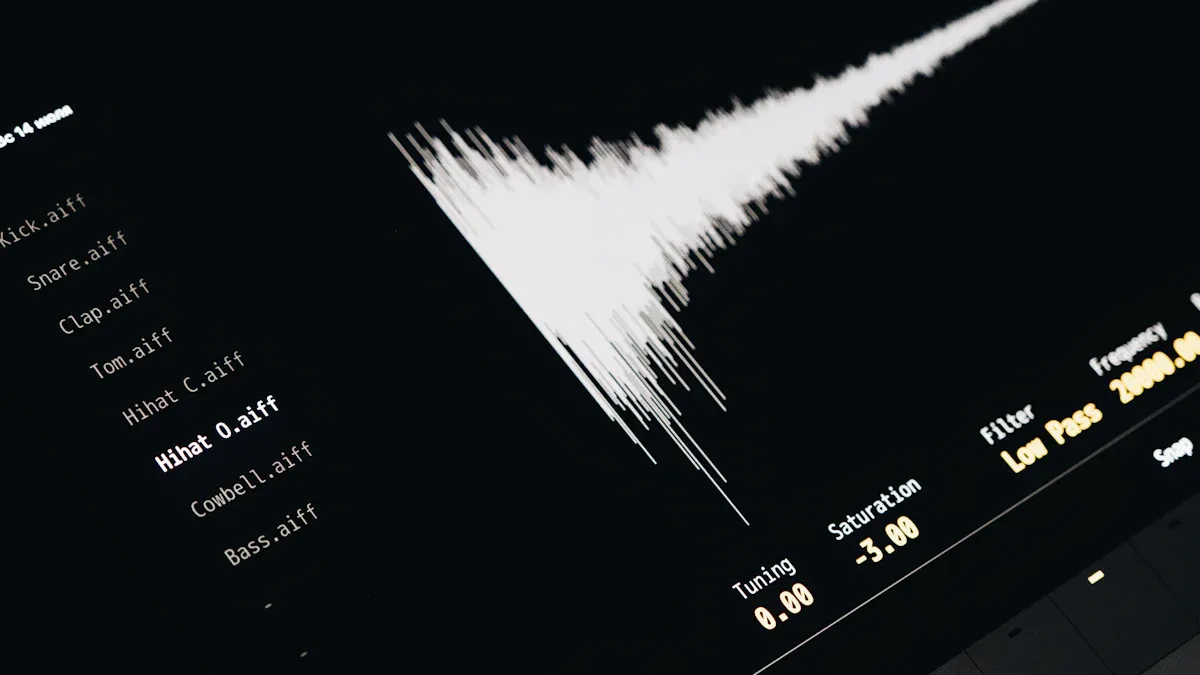3 Ways the Role of Frequency Impacts Vibration

The role of frequency is key to understanding how vibration works. It affects how strong the vibration feels, its patterns, and its steadiness. For example, vibration studies show main frequencies in directions like X, Y, and Z often stay in certain ranges, such as 22 Hz to 26 Hz or 72 Hz to 78 Hz. These frequencies help engineers make better designs and keep things safe. Whether studying machine vibrations or natural systems, knowing how the role of frequency connects to vibration is important for good predictions and useful results.
Key Takeaways
Frequency affects how vibrations feel. Low frequencies make big movements, while high frequencies feel stronger with the same movement size.
Knowing about frequency helps engineers make safer machines. By studying vibration frequencies, they can stop damage and improve how machines work.
Resonance happens when vibrations match a system's natural rhythm. This can cause strong vibrations that might harm buildings or machines if not fixed.
Engineers use tools like modal analysis to study frequency effects. These tools help them predict vibrations and make designs safer and more stable.
Controlling frequency is important for safety. Using damping materials or changing designs can stop resonance problems and keep systems working well.
Frequency Decides How Strong Vibrations Feel
How Frequency Affects Movement Size
Frequency and amplitude work together to shape vibrations. Lower frequencies make bigger movements, which are easier to notice. For example, moving your hand at 1 Hz creates large shifts. But at 100 Hz or higher, the same movement needs more speed, making it harder to do. This shows how movement size changes with frequency levels.
Looking closer, vibrations behave differently at various frequencies. Below 10 Hz, displacement is the main factor. Between 10 Hz and 1,000 Hz, velocity matters most. Above 1,000 Hz, acceleration becomes key. These changes show why understanding frequency is important for studying vibration strength.
Frequency Range | Type of Movement |
|---|---|
Below 10 Hz | Displacement |
10 - 1,000 Hz | Velocity |
Above 1,000 Hz | Acceleration |
Higher Frequencies Feel Stronger
High frequencies make vibrations feel stronger. Studies show a clear link between certain frequency bands and vibration strength. For example, Delta, Theta, and Alpha bands have correlation scores over 0.76, with p < 0.001. This means higher frequencies can feel stronger, even if the movement size stays the same.
Frequency Band | Correlation Score | Significance Level |
|---|---|---|
Delta | 0.7604 | p < 0.001 |
Theta | 0.7961 | p < 0.001 |
Alpha | 0.7845 | p < 0.001 |
Using Frequency in Machines
In machines, studying frequency helps control vibrations better. One example is Hazleton Pumps. Engineers found their pump vibrated too much near 780 RPM. They changed how the pump worked, keeping it above 950 RPM. This fixed the vibration problem.
This shows how knowing about frequency can improve machines and stop damage. Whether building factory tools or gadgets, checking vibration frequencies keeps things safe and steady.
Frequency Shapes Vibration Patterns

Frequency and Unique Vibration Modes
Frequency plays a big role in creating unique vibration modes. Structures naturally vibrate at certain frequencies, called resonance frequencies. Each resonance frequency has its own special movement pattern, or mode shape. For example:
Mode shapes happen when resonance frequencies interact with a structure's properties.
Frequency response functions (FRFs) show how different modes affect vibrations.
Engineers use FRFs to study frequency effects and make designs more stable.
Looking at frequency peaks in the FFT spectrum helps analyze these modes. By studying how many cycles happen each second, you can predict how structures react to different vibration frequencies.
Examples in Nature and Technology
Nature and technology give cool examples of how frequency shapes vibrations. Cymatics shows how sound vibrations make visible patterns in materials. Different frequencies create different shapes, linking vibration to frequency.
Hans Jenny’s experiments showed how materials react to changing frequencies. He found that cycles per second create complex patterns. DNA vibrations also show how resonance aligns parts of DNA, proving frequency affects biology too.
These examples explain how frequency peaks help us understand vibrations in nature and technology.
Engineering Uses of Frequency in Vibration Study
Engineers study frequency to understand vibrations and improve designs. Modal analysis is a method that finds natural frequencies and mode shapes in structures. The main equation for free vibration is:
$\begin{aligned} [M] {\ddot{u}(t)} + [C] {\dot{u}(t)} + [K] {u(t)} = 0, \end{aligned}$
This equation shows how stiffness, mass, and damping affect vibration. Solving it helps engineers find frequency effects and make systems safer and better.
Modal analysis also uses the FFT spectrum to find frequency peaks. This method helps predict vibrations accurately and control cycles per second in machines and structures.
Frequency Affects Resonance and Stability
What Resonance and Frequency Mean
Resonance happens when something vibrates at its natural rhythm. This makes the vibration stronger instead of weaker. It’s like finding a "perfect match" for vibrations. Frequency plays a big role in this process. Studies show resonance frequency depends on things like heartbeats and breathing. Slow, steady breathing can make resonance stable. This helps improve heart health and keeps your heartbeat steady.
Evidence Description | Findings |
|---|---|
Resonance frequency changes with heartbeat intervals | Controlled breathing raises heart rate and lowers IBI, keeping resonance steady. |
Average resonance frequency in people | Most people had a resonance frequency near 6 b/m (0.1 Hz), with some at 7 b/m. |
In engineering, the Sauerbrey equation shows how frequency links to weight. This helps predict how vibrations act in small and big systems.
Problems from Resonance Instability
Resonance can cause problems if not handled well. When vibrations match a system’s natural rhythm, they can grow too strong. This can harm structures, break machines, or even cause accidents. For example, bridges and buildings must avoid resonance from wind or cars.
Material properties like stiffness and strength help engineers predict how things handle vibrations. Systems with weak parts or poor damping are more at risk of resonance problems.
Main dangers of resonance include:
Strong vibrations that weaken structures.
Faster wear and tear on machines.
Safety risks in important systems.
Controlling Frequency for Safety
To keep things safe, frequency must be controlled in vibration studies. Engineers use tools like modal analysis to find resonance frequencies and fix designs. For example, testing machine speeds can find risky frequencies. Changes like adding damping materials or making parts stiffer can move resonance to safer levels.
In medicine, stability tests show why managing frequency matters. Checking products at times like 0, 3, 6, and 12 months ensures safety. Similarly, engineers check vibrations often to keep systems working well.
By learning how frequency affects resonance, you can make safer and stronger designs. Whether it’s machines, buildings, or even living things, controlling frequency is key for safety and success.
Frequency is important in vibration systems. It affects strength, patterns, and stability. Knowing how frequency works with vibration helps improve safety and performance.
Strength: Tools like peak amplitude and RMS measure vibration power. Crest factor and PSD show how stress spreads and changes over time.
Patterns: Frequency creates special vibration modes in systems and structures. Engineers use modal analysis to study these modes and make better designs.
Resonance and Stability: Controlling resonance stops damage and keeps systems safe. Adding damping or making parts stiffer helps avoid problems.
Data shows why frequency matters for safety. For example:
Metric | What It Tracks |
|---|---|
Measures how often injuries happen. | |
Lost Workday Incident Rate (LWIR) | Tracks serious accidents that cause missed workdays. |
Training Completion Rate (TCR) | Links safety training to fewer accidents. |
From stopping hand-arm vibration issues to lowering injury risks, studying frequency helps reduce harm and makes systems more reliable.
FAQ
What is vibration-induced injury?
Vibration-induced injury happens when vibrations harm your body over time. It can damage nerves, blood vessels, or muscles, especially in hands and arms. This often comes from using vibrating tools or machines for long periods.
How does frequency affect vibration exposure?
Frequency controls how vibrations impact your body. Low frequencies might feel uncomfortable, while high frequencies can cause injuries. Knowing about frequency helps you stay safe and lower risks at work.
What are the risks of prolonged vibration exposure?
Long-term vibration exposure can cause health problems like HAVS. This condition weakens grip strength, harms circulation, and damages nerves. It may also lead to lasting pain or trouble moving affected areas.
How can you reduce vibration-related risks?
You can lower risks by taking breaks and limiting exposure time. Use tools that reduce vibrations and wear protective gear. Keeping tools in good shape also helps prevent injuries and improves safety.
Why is frequency important in occupational exposure?
Frequency matters because it affects how vibrations harm your body. Understanding it helps create safer workplaces and lowers the chance of vibration-related injuries.
See Also
Understanding Resonance and Frequency for Vibration Engineering Success
Frequency and Vibration: Essential Insights for Motor Efficiency
Distinguishing Vibration and Frequency for Improved Motor Design
Get Custom Micro DC Motors from
INEED Motors!
Leading Brand in Vibration Motor Manufacturing Industry
